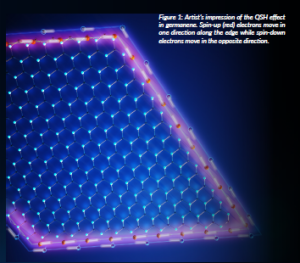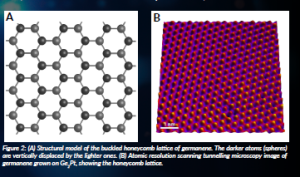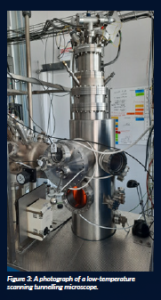Quantum spin Hall (QSH) insulators or 2D topological insulators are a special class of materials. They are characterised by an insulating bulk and two counter-propagating, spin-polarised edge states protected by time-reversal symmetry (Hasan and Kane, 2010).
In lay terms, the centre of these materials behaves like an insulator, where current flows with high resistance, while the rim, or edge, acts as a pair of one-way lanes for electrons whose direction is locked to their spin. Because the opposing lanes never collide, electrical current can flow along the edge without resistance, meaning virtually no energy gets wasted as heat. See Figure 1 for an artistic representation of the QSH effect.
This so-called dissipationless transport is the holy grail of low-energy electronics, and if realised, has the potential to revolutionise our technologies (Gilbert, 2021; Weber, 2024). On top of that, these materials offer a template to realise novel states of matter with even more exotic properties, such as Majorana zero modes; particles that are their own antiparticles, have fascinated the scientific community and might allow the realisation of topological qubits (Kitaev, 2001; Fu and Kane, 2008; Jäck, 2019).
The challenges
However, a lack of fundamental understanding of the physics that governs the electron interactions and charge transport in these systems prevents us from realising their full potential. This stems from several experimental challenges that fall within the following four key bottlenecks. Firstly, most QSH insulators work only near absolute zero because their band gaps are small, which makes experimental perusal challenging. Secondly, the ‘chemical gate’ that controls which electrons move must be set precisely inside the gap. Otherwise, bulk currents prevent us from isolating the edge signal. Thirdly, there is a need for clear markers to distinguish experimental results that are truly topological from artefacts arising from impurities or ordinary surface and defect states. Moreover, edge channels are only an atom wide. This means that conventional device architectures might disturb more than they reveal. Even if we overcome these challenges, real materials might pose extra obstacles. Rough edges, stray magnetic atoms, and trapped charges could further disturb the perfect theoretical picture making the interpretation of experimental results a real challenge.
Germanene
In Q-EDGE, we have the possibility and tools to resolve these challenges and move the field forward, thanks to a unique combination of a novel material and state-of-the-art microscopy. This unique material, germanene, effectively allows us to solve the aforementioned material-related challenges. Germanene is a material that is very similar to graphene; it consists of a monolayer of germanium atoms arranged in a low-buckled honeycomb lattice (Cahangirov, 2009). A ball and stick model of the structure of germanene is shown in Figure 2A, and an atomic resolution scanning tunnelling microscopy (STM) image of germanene is shown in Figure 2B. Germanene has some unique properties. It is a QSH insulator with a large band gap (due to its heavy Ge atoms), enabling experiments up to room temperature with a clear separation of edge and bulk states (Kane and Mele, 2005). Its low-buckled honeycomb lattice is unique, as most 2DTIs are planar. The buckling enables the breaking of specific material symmetries (inversion and time-reversal symmetries) independently, providing experimental ‘knobs’ (e.g. electric fields) to transition the system from topological to trivial (Bampoulis, 2023). In Q-EDGE, we use this feature of germanene as a tool to distinguish topological from trivial effects that obscure current investigations, without the need for doping. Therefore, using a small gate voltage, we are able to switch germanene between ‘normal’ and topological phases, providing an internal control experiment. Another aspect of germanene that makes it very special is its 2D nature (Van der Waals out-of-plane interactions), which allows us to engineer it into a variety of substrates (Zhang, 2016) and thus further modify its properties by the proximity effect (Bampoulis, 2023). These properties of germanene provide an ideal platform for further exploring the electronic and topological properties of QSH insulators up to room temperature.
A microscope that resolves individual atoms
This edge-only conduction in germanene and other QSH insulators could power new kinds of low-energy electronics, but it is extremely difficult to study. More conventional tools, such as electrical probe stations, photoemission, or lithographically made devices, average signals over the entire sample, so the edge signal disappears in the noise of the bulk signal. Therefore, we need to use ultra-precise tools that can ‘see’ and characterise the edge with atomic accuracy.
In Q-EDGE, we will use multiprobe STM. A photograph of a low-temperature STM is shown in Figure 3. STM is a technique that allows for ultra-precise characterisation of one-dimensional edge states with atomic accuracy. This is possible thanks to a phenomenon called quantum tunnelling. When a metallic tip is brought within a nanometre distance of a conductive surface and a bias voltage is applied, a tunnelling current flows. By raster-scanning the tip while keeping the tunnelling current (or tip-sample distance) constant, we can use STM to map both topography and electronic properties with atomic resolution. In Q-EDGE, we take it one step further and utilise four independently controlled, atomically sharp tips. These tips can be positioned within ~50 nm of each other and brought either into tunnelling or into gentle contact (a few nN) with the QSH edge (under ultra-high-vacuum conditions). A schematic of the envisioned experiment is shown in Figure 4. The instrument thus becomes also an in-situ, lithography-free, four-terminal device. This allows for the isolation of transport arising from the one-dimensional edge channel, the quantification of its conductance, and the testing for the helicity expected in QSH systems, all without sample transfer or additional nanofabrication, while simultaneously measuring the topography and electronic properties of the material with atomic precision.
Objectives
Therefore, using germanene as a template material and multiprobe STM as the tool of choice, in Q-EDGE, we are working towards three key objectives:
- The first PhD student is working to uncover the fundamental principles of charge and spin transport in QSH insulators. To do so, we will use a three-terminal STM setup to resolve the spin polarisation in individual edge channels and test helical Luttinger liquid theory by measuring charge transport characteristics with tunnelling spectroscopy as a function of voltage and temperature.
- The second PhD student will identify why transport experiments on edge states might deviate from the ballistic 2e2/h conductance, and pinpoint possible back-scattering mechanisms and ways to mitigate them. To do so, the student will use our multiprobe STM setup in a linear probe configuration with varying probe spacing to extract the edge mean free path. Magnetic impurities and charge puddles will be introduced deliberately in a controlled manner. This way, we will measure differential conductance maps to understand the scattering processes.
- The third PhD student will combine superconducting and magnetic proximity effects to create localised Majorana zero modes. This will be done by fabricating germanene/ NbSe₂ heterostructures and by studying ferromagnetic defects in these heterostructures. The double knob that germanene offers to test topological properties offers an additional signal to search for exotic zero-energy states.
Looking ahead
By the end of its five-year run, Q-EDGE aims to transform the physics of one-dimensional edge states from a laboratory curiosity into a design element for both classical and quantum technologies. The project will advance fundamental science by finding new topological states and providing a system for new research into topological phenomena. Together with my collaborators, I will update theories of these complex quantum phases and provide a comprehensive understanding of the physics that governs the topological properties of these systems. Moreover, we anticipate that Q-EDGE will also have long-term benefits. As the energy demands of Si-based electronics are expected to exceed our current energy production soon, there is an urgent need for new materials with superior properties. Q-EDGE provides these materials and a fundamental framework to address this looming crisis.
References
Bampoulis, P., Castenmiller, C., Klaassen, D.J., van Mil, J., Liu, Y., Liu, C.-C., Yao, Y., Ezawa, M., Rudenko, A.N. and Zandvliet, H.J.W. (2023) ‘Quantum spin Hall states and topological phase transition in germanene’, Physical Review Letters, 130(19), 196401. doi: 10.1103/PhysRevLett.130.196401.
Cahangirov, S., Topsakal, M., Aktürk, E., Şahin, H. and Ciraci, S. (2009) ‘Two- and one-dimensional honeycomb structures of silicon and germanium’, Physical Review Letters, 102, 236804.
Fu, L. and Kane, C. L. (2008) ‘Superconducting proximity effect and Majorana fermions at the surface of a topological insulator’, Physical Review Letters, 100, 096407.
Gilbert, M. J. (2021) ‘Topological electronics’, Communications Physics, 4, p. 70.
Hasan, M. Z. and Kane, C. L. (2010) ‘Colloquium: Topological insulators’, Reviews of Modern Physics, 82(4), pp. 3045–3067.
Jäck, B., Xie, Y., Li, J., Jeon, S., Bernevig, B. A. and Yazdani, A. (2019) ‘Observation of a Majorana zero mode in a topologically protected edge channel’, Science, 364(6447), pp. 1255–1259.
Kane, C. L. and Mele, E. J. (2005) ‘Quantum spin Hall effect in graphene’, Physical Review Letters, 95, 226801.
Kitaev, A. Y. (2001) ‘Unpaired Majorana fermions in quantum wires’, Physics-Uspekhi, 44, pp. 131–136.
Weber, B., Fuhrer, M.S., Sheng, X.-L., Yang, S.A., Thomale, R., Shamim, S., Molenkamp, L.W., Cobden, D., Pesin, D., Zandvliet, H.J.W., Bampoulis, P., Claessen, R., Menges, F.R., Gooth, J., Felser, C., Shekhar, C., Tadich, A., Zhao, M., Edmonds, M.T., Jia, J., Bieniek, M., Väyrynen, J.I., Culcer, D., Muralidharan, B. and Nadeem, M. (2024) ‘2024 roadmap on 2D Topological Insulators’, Journal of Physics: Materials, 7(2), 022501. doi: 10.1088/2515-7639/ad2083.
Zhang, L., Bampoulis, P., Rudenko, A.N., Yao, Q., van Houselt, A., Poelsema, B., Katsnelson, M.I. and Zandvliet, H.J.W. (2016) ‘Structural and electronic properties of germanene on MoS2’, Physical Review Letters, 116(25), 256804. doi: 10.1103/PhysRevLett.116.256804.
PROJECT NAME
Living on the edge: unravelling electron correlations and topological transport in quantum spin Hall insulators
PROJECT SUMMARY
Q-EDGE investigates atomically thin materials that exhibit the quantum spin Hall (QSH) effect. These materials are characterised by a band gap at their interior and metallic states at their edges. These topologically protected edge states promise to revolutionise low-energy electronics and quantum computing. In this project, we grow atomically clean sheets of germanene, a honeycomb material that exhibits the QSH effect, and using state-of-the-art scanning probe microscopies, we try to understand how the electrons move along the edges of germanene, what causes deviations from the ideal transport behaviour, and how to engineer further germanene to host exotic quantum states called Majorana zero modes. The project could impact fields ranging from low-energy electronics to quantum computing.
PROJECT LEAD PROFILE
Pantelis Bampoulis earned his PhD with honours in Applied Physics from the University of Twente in 2017 and held a 2018 Humboldt Fellowship at the University of Cologne developing 2D nanostructures. Now Associate Professor at Twente, he leads research on 2D topological insulators and heterostructures, including the quantum spin Hall effect in germanene. He is supported by prestigious grants to advance quantum materials and their applications.
PROJECT CONTACTS
Physics of Interfaces and Nanomaterials MESA+ Research Institute
Faculty of Science and Technology University of Twente
PO Box 217
7500 AE Enschede The Netherlands
+315 34895413
Email: p.bampoulis@utwente.nl
Web: www.utwente.nl/en/tnw/pin/research/Topological%20Quantum%20Matter%20Lab/
FUNDING DISCLAIMER
This project has been funded by The European Research Council (ERC) under the European Union’s Horizon Europe research and innovation programme grant agreement number 101162852.
Views and opinions expressed are however those of the author(s) only and do not necessarily reflect those of the European Union or the ERC. Neither the European Union nor the granting authorities can be held responsible for them.
Figure legends
Figure 1: Artist’s impression of the QSH effect in germanene. Spin-up (red) electrons move in one direction along the edge, while spin-down electrons move in the opposite direction.
Figure 2: (A) Structural model of the buckled honeycomb lattice of germanene. The darker atoms (spheres) are vertically displaced by the lighter ones. (B) Atomic resolution scanning tunnelling microscopy image of germanene grown on Ge2Pt, showing the honeycomb lattice.
Figure 3: A photograph of a low-temperature scanning tunnelling microscope.
Figure 4: A schematic representation of a four-probe STM contacting a QSH edge state.





